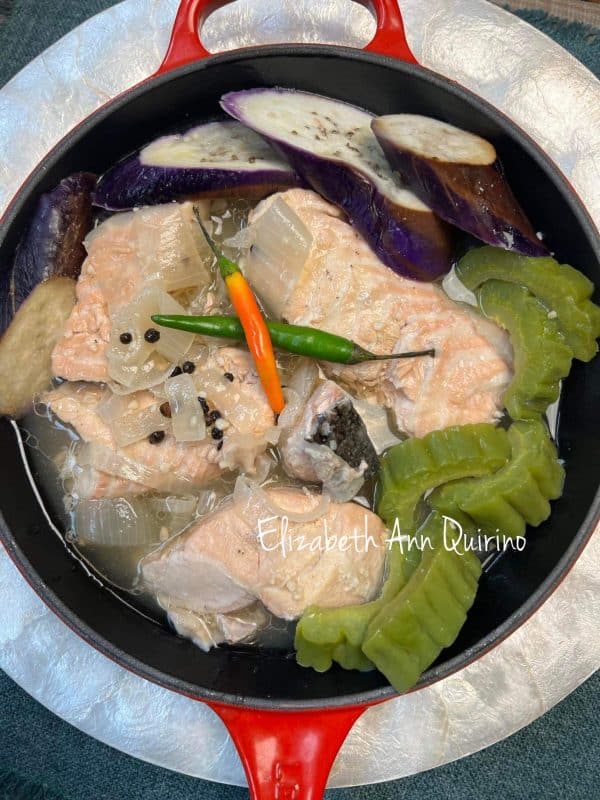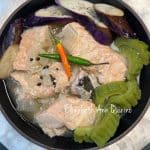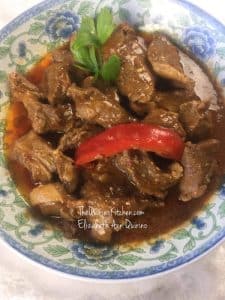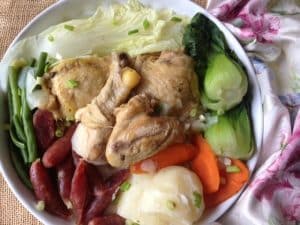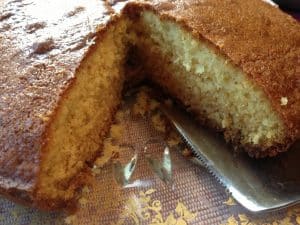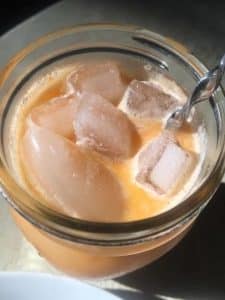Paksiw na Salmon Belly
As an Amazon Associate and member of other affiliate programs, I earn from qualifying purchases.
I cooked Paksiw na Salmon Belly because we haven’t been back home to the Philippines since pre-pandemic and I craved the tangy flavors of paksiw. Whenever we go back to our house where I grew up, I request for my favorite tart, savory Paksiw na Isda, which my sister cooks with a whole bangus (milkfish). Since bangus is hard to find where we live here in the States, I bought salmon belly instead.
Paksiw na Isda is a Filipino fish stew cooked in vinegar, salt, ginger, garlic, peppercorns, and some finger chilies are added for a zing. The term paksiw refers to a method of cooking in vinegar.
At first glance, you will see fillets of fish in a clear-looking broth, with slices of eggplants and ampalayas (bitter melon), softly nestled next to it. A teaspoon of black peppercorns are strewn around. You will have no clue what it tastes like, till your spoon slips into the silky fish pieces. Using salmon belly was the best choice I made. Salmon belly has more fat, which made the tangy stew more flavorful. When simmering in the vinegar-flavored broth spiked with ginger and garlic, the strong, sharp aromas come through and linger on. I added the vegetables to make it an all-in-one meal.
Like most stews cooked with vinegar, this paksiw tastes more superb days after, if there’s any left. The tartness gets milder as days go by, and the sweetness of the vinegar-garlic-ginger combination sets in. Make sure there’s enough steamed rice ready to pair with this delightfully easy Paksiw na Salmon Belly. There’s nothing like letting the garlicky paksiw sauce seep through the soft rice grains, and allowing yourself to savor the simplicity of this wonderful dish.
Paksiw na Salmon Belly
Equipment
- Medium to Large Stockpot
- Mixing bowl (non reactive)
Ingredients
- 1 pound salmon belly
- 3 Tablespoons salt
- 3 cups water
- 1 whole onion, sliced
- 1 knob (1 inch) fresh ginger, peeled, sliced
- 6 cloves garlic, minced
- 1/2 cup white vinegar; like Datu Puti (Filipino brand), or store-brand white distilled vinegar
- 1 cup broth (vegetable or fish)
- 1 Tablespoon vegetable oil
- 1 Tablespoon patis (fish sauce)
- 1 whole Asian eggplant, sliced; about 1 cup
- 1 whole ampalaya (bitter melon), sliced, seeded; about 1 cup white membrane removed
- ½ teaspoon salt
- ¼ teaspoon ground black pepper
- 1 teaspoon black peppercorns
- 2 pieces siling mahaba (finger chilies)
For serving
- steamed rice
- ¼ cup patis (fish sauce); as a side dipping sauce
Instructions
To prepare the salmon belly:
- In a non-reactive mixing bowl, place the salmon belly. Pour water and add the 3 tablespoons of salt. Soak fish for 30 minutes.When done, drain and discard the water. Set the fish aside.
To cook the Paksiw na Salmon Belly:
- In a stockpot, layer the sliced onions at the bottom.Place the whole salmon belly piece on top of the onions. Add the garlic, and ginger to the layers.Place the eggplants and amplaya slices next to the fish.
- Pour the liquids: vinegar, broth, oil and patis.Season with salt, black pepper and peppercorns. Add the siling mahaba (finger chilies).
- Over medium heat and uncovered, simmer the Paksiw for 15 to 20 minutes till fish is completely cooked and vegetables are soft.When paksiw has cooled, refrigerate in a covered container for at least one day.The next day, reheat the Paksiw and serve warm with rice.
Cook's comments:
- If you want to tone down the spicy level of this dish, omit the siling mahaba or remove the chilies right after simmering. This Paksiw na Salmon Belly can be served and eaten as soon as it is cooked if desired. But the vinegary-garlic flavors set in better at least a day after.
Nutrition
Notes on Nutrition: The nutrition information provided in the recipe links is an estimate and will vary based on cooking methods and specific brands of ingredients used.
Copyright Notice: Hello, Friends! Please DO NOT LIFT OR PLAGIARIZE Asian in America recipes on this blog, my original recipes, stories, photos or videos. All the images and content on this blog are COPYRIGHT PROTECTED and owned by my media company Besa-Quirino LLC by Elizabeth Ann Quirino. This means BY LAW you are NOT allowed to copy, scrape, lift, frame, plagiarize or use my photos, essays, stories and recipe content on your websites, books, films, television shows, videos, without my permission. If you wish to republish this recipe or content on media outlets mentioned above, please ASK MY PERMISSION, or re-write it in your own words and link back to my blog AsianInAmericaMag.com to give proper attribution. It is the legal thing to do. Thank you. Email me at [email protected]
– 3 Tablespoons salt

